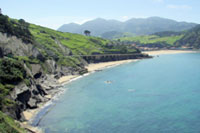- Home
- Discovering the Basque Country
Introduction
The Basque Country, in a wonderful geographic setting, is the gateway connecting the Iberian Peninsula to Europe. It is located at the most Easterly point of the Cantabrian coast and covers an area of 7,234 km². This is a land of contrasts and the variety of landscapes is one of its main hallmarks, but not the only one. The Basque language, possibly the oldest in Europe, along with the region’s culture and its people make the Basque Country a first-class tourist destination.

With a population of 2,178,339 inhabitants, it is organised into three "Historical Territories", namely Araba-Álava, Bizkaia and Gipuzkoa, with their respective capitals. These are a reflection of the rich diversity in the Region. Vitoria-Gasteiz, capital of the Autonomous Community of the Basque Country and home to the Regional Government and Parliament, is a leading example of urban development and will be the European Green Capital 2012; Bilbao, industrial and financial capital of the Basque Country, has been outstandingly transformed over the last few years into a vibrant metropolis, leading to it winning the Lee Kuan Yew World City Prize. Donostia-San Sebastian, a modern city and one with a decidedly cultural feel, has based its development over the last few years on an integrated policy of supporting science, technology and sustainable development. Its candidacy for European Capital of Culture 2016 (www.sansebastian2016.eu) is evidence of the approach taken by the city.